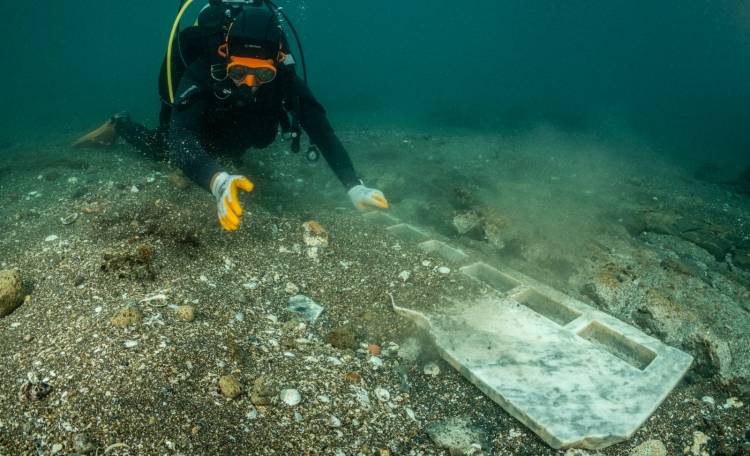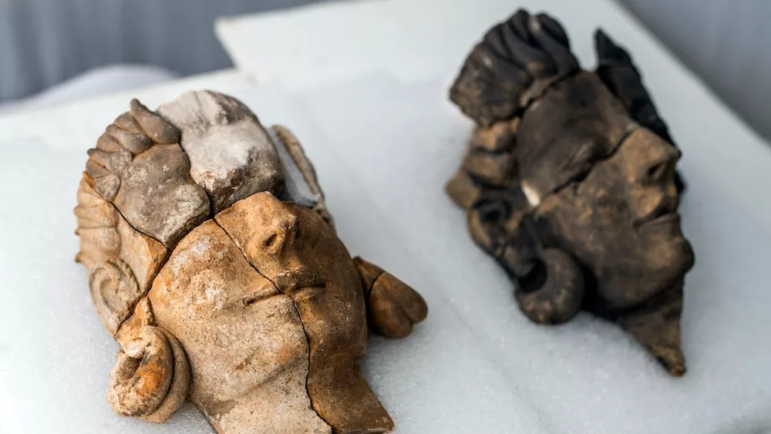ROME – Two archeological discoveries in the Mediterranean shed light on some ancient cultures we still know very little about.
Earlier last month, archeologists from two universities in Naples (the Università degli studi della Campania Luigi Vanvitelli and Scuola Superiore Meridionale) excavating the Roman town of Baia often referred to as the “Las Vegas of the Roman Empire.” in the Gulf of Naples made a surprising discovery: a heretofore unknown temple. Baia was once a prominent and wealthy town frequently visited by the Roman elite and had villas owned by emperors Julius Caesar, Nero, and Hadrian. Seneca the Younger referred to Baia as a “vortex of luxury” and “harbor of vice.”
Baia was sacked twice but it was volcanic activity that destroyed the city. Nearby volcanoes created shifting land and Baia ultimately went below sinking beneath the Mediterranean Sea. Baia is now offshore near the modern city of Pozzuoli.
The archeologists found two Roman marble altars but the temple was dedicated to Dushara, a pre-Islamic Arabian god associated with Zeus and Dionysus and worshipped by the Nabateans.

Remains of the Nabatean temple marbles (via Italian Ministry of Culture)
The Nabataeans were an ancient Arab people who inhabited northern Arabia and the southern Levant. Their settlements most prominently throughout present-day Jordan gave the name Nabatene to the Arabian borderland that stretched from the Euphrates to the Red Sea.
The Nabataeans were originally nomadic, but they began to settle in the region of Petra in the 6th century BCE. They quickly became skilled traders, and they soon controlled the lucrative incense trade between Arabia and the Mediterranean world. The Nabataeans were also skilled engineers and architects, and they built a number of impressive cities and temples including the city originally named Raqmu called now Al-Batrā and known in the West as Petra, a UNESCO World Heritage Site and one of the most popular tourist destinations in the world. Their culture and art had a significant impact on the Roman Empire
In the 1st century BCE, the Nabataeans came into conflict with the Roman Empire. Though they were able to maintain their independence for several decades the Nabataean Kingdom was annexed by the Roman Empire under Trajan, in 106 CE and Petra became a Roman city. With their annexation and previous truces with Rome, the Nabateans were allowed to travel freely in the region controlled by Imperial Rome establishing the ancient city of Puteoli, the largest commercial port in the Roman Mediterranean and now called Pozzuoli with Baia just to the east.
The temple discovery helps verify the Nabatean presence in southern Italy. It also highlights the Nabatean dedication to their faith as they carried their gods with them to new destinations. “Ancient Puteoli reveals another of its treasures, which testifies to the richness and vastness of commercial, cultural and religious exchanges in the Mediterranean basin in the ancient world,” said Italy’s Minister of Culture Gennaro Sangiuliano, in an announcement of the discovery of the Nabataean temple.
More Nabatean ruins could be located in the same area and their excavation may help the continued deciphering of the Nabatean language.
Meanwhile, in the Western Mediterranean, a team of archeologists from Instituto de Arqueología, centro mixto del Consejo Superior de Investigaciones Científicas (CSIC) y la Junta de Extremadura, confirmed at a press conference in mid-April the discovery of five life-size busts of human figures that likely depict goddess wearing gold earrings. The figures may be the first-known depictions of the Tartessos, an ancient culture that vanished from the area 2,500 years ago.
The Tartessians were an ancient people who lived in the southwestern Iberian Peninsula (modern-day Spain and Portugal) from the 12th to the 6th centuries BC. They were a mix of indigenous Iberians and Phoenicians, and they developed a sophisticated culture that was influenced by both cultures. They were the first major civilization to develop in the Iberian Peninsula, and their culture had a significant impact on the development of later cultures in the region.

Two of the stone heads were found at Casas del Turuñuelo (Badajoz). / Samuel Sánchez (El País) via CSIC.
The Tartessians were known for their metalworking skills, and they were major exporters of silver, copper, and tin. They also traded in other goods, such as wine, olive oil, and pottery. The Tartessians were also skilled sailors, and they established a network of trade routes throughout the Mediterranean. While dismissed by the scientific community, the Tartessos people have been linked to the story of Atlantis.
As a result of their trade and skills, the Tartessians became wealthy and powerful, and their culture was highly developed. They had a written language, and they built impressive temples and palaces, but until now, none of their architectural remains had images of the people.
The Tartessian civilization declined in the 6th century BC, and it was eventually absorbed by the neighboring Iberians and Celts. However, the Tartessians left a significant legacy behind them, including exceptional skills in goldsmithing. However, they appeared to avoid representations of themselves.
The carved stone faces were found by CSIC archaeologists led by Esther Rodríguez González y Sebastián Celestino Pérez. The team dates them to the fifth century B.C.E. The faces were found hidden inside a sealed pit in an adobe temple at Casas del Turuñuelo, an ancient Tartessian site near the town of Guareña near Cáceres, Spain. The pieces were scattered amongst animal bones, mostly from horses, that likely came from a mass offering.
“The unusual thing about the new finding is that the representations correspond to human faces,” Erika López, a CSIC spokesperson, said in the statement.
Along with the two female figurine heads, other fragments have been recovered. These fragments belong to at least three other individuals, one of them identified as a warrior because part of a helmet remains preserved in the sculpture. The culture was believed to avoid idolizing human figures.
The team wrote in the statement, “This extraordinary find represents a profound paradigm shift in the interpretation of Tartesus, traditionally considered an aniconic culture for representing divinity through animal or plant motifs, or through betilos (sacred stones).”
The Wild Hunt is not responsible for links to external content.
To join a conversation on this post:
Visit our The Wild Hunt subreddit! Point your favorite browser to https://www.reddit.com/r/The_Wild_Hunt_News/, then click “JOIN”. Make sure to click the bell, too, to be notified of new articles posted to our subreddit.